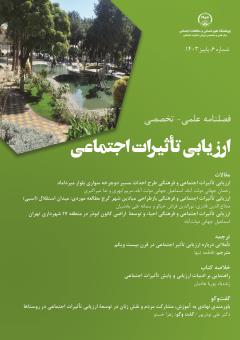ارزیابی تأثیرات اجتماعی و فرهنگی بازطراحی میادین شهر کرج مطالعه موردی: میدان استقلال (اسبی)
محورهای موضوعی :
صلاح الدین قادری
1
![]() ,
نورالدین فراش خیالو
2
,
سمانه علی بخشیان
3
,
نورالدین فراش خیالو
2
,
سمانه علی بخشیان
3
1 - دانشیار گروه جامعه¬شناسی دانشگاه خوارزمی
2 - دانشجوی دکترای جمعیتشناسی
3 - دانشجوی کارشناسی ارشد جامعه شناسی دانشگاه خوارزمی
کلید واژه: ارزیابی تأثیرات اجتماعی, میدان استقلال کرج, تأثیرات فرهنگی, تأثیرات محیط¬زیستی و تأثیرات اقتصادی,
چکیده مقاله :
پژوهش حاضر از نوع پژوهشهای ارزیابی تأثیرات اجتماعی و فرهنگی است که با هدف شناسایی تأثیرات طرح بازطراحی میدان استقلال شهر کرج، شناسایی ذینفعان، بستر اجتماعی پروژه، واکنشهای ممکن به پروژه، سناریوهای پیش روی طرح و... انجام گرفته است. مباحث مفهومی و نظری پشتیبان مطالعه اتاف، مباحث نظری حوزه اتاف و فضاهای عمومی شهری و الزامات طراحی آنهاست. روش اجرای پروژه از نوع ترکیبی (کمی و کیفی) با تأکید بر مطالعات میدانی مبتنی بر پیمایش، مصاحبه فردی و گروهی، بررسی اسناد و مطالعات تطبیقی است. روش تحلیل یافتهها مبتنی بر روشهای تحلیلی و توصیفی، تحلیل محتوا، سناریونویسی و تحلیل ذینفعان است. یافتههای پژوهش نشان میدهد که ساکنان محلی تاحدود زیادی با اجرای طرح موافق هستند. در میان ذینفعان دارای قدرت بالا و تأثیرگذاری بالا (پلیس راهور، معاونت ترافیک، سازمان سیما و منظر و همچنین سازندگان محلی)، مخالفت با اجرای طرح پیشنهادی معاونت شهرسازی زیاد است و طرح را عامل ایجاد ترافیک و شلوغی بیشتر میدانند. بر اساس چهار سناریوی پیش روی طرح، سناریوی تعدیل مورد تأیید مطالعه اتاف است و پیشنهادهایی در راستای این سناریو ارائه شده است.
This research is a type of social and cultural impact assessment research, which was conducted with the aim of identifying the effects of Shahr Karaj's Esteghlal Square redesign project, identifying the beneficiaries, the social background of the project, possible reactions to the project, scenarios ahead of the project, etc. Conceptual and theoretical issues supporting the study of OTAF are theoretical topics in the field of OTAF and urban public spaces and their design requirements. The project implementation method is of a mixed type (quantitative and qualitative) with an emphasis on field studies based on survey, individual and group interviews, document review and comparative studies. The method of analyzing the findings is based on analytical and descriptive methods, content analysis, scenario writing and stakeholder analysis. The findings of the research show that the local residents largely agree with the implementation of the plan. Among the stakeholders with high power and high influence (traffic police, traffic deputy, Sima and Manzar organization and also local builders), there is a lot of opposition to the implementation of the proposed plan of the urban development deputy, and they consider the plan to cause more traffic and congestion. Based on the 4 scenarios ahead of the plan, the adjustment scenario is approved by the study of Ataf and suggestions have been made in line with this scenario.
ابراهیمی، مرضیه (1391). ارزیابی تأثیرات اجتماعی سامان¬دهی میدان امام خمینی(ره). پروژه مطالعاتی، شهردار منطقه 12. اداره مطالعات اجتماعی شهرداری تهران.
پاکزاد، جهانشاه (1385). مباني نظري و فرايند طراحي شهري. تهران: شهيدي.
پورصباغ، علیرضا (1393). ارزیابی تأثیرات اجتماعی و فرهنگی طرح ایجاد و توسعه ناحیه صنعتی میدان مرکزی میوه و تره¬بار شهر تهران. پروژه مطالعاتی، معاونت خدمات شهری سازمان میادین و ترهبار شهر تهران.
حبیبزاده، رامین (1393). ارزیابی تأثیرات اجتماعی و فرهنگی سامان¬دهی میدان محمدیه. پروژه مطالعاتی، سازمان زیباسازی شهر تهران.
ساسانپور، فرزانه (1393). ارزیابی تأثیرات اجتماعی و فرهنگی معابر و میادین خاص منطقه 2 شهردار تهران (میدان شهید تهرانی مقدم، قیصر امین¬پور، کتاب و صنعت). پروژه مطالعاتی، شهرداری منطقه 2 تهران.
سرنی، مایکل ام (1399). ارزیابی تأثیرات اجتماعی و سیاستهای پادمانی بر سر یک دوراهی: مسیر روبه جلو باید رو به بالا باشد. در: ارزیابی تأثیرات اجتماعی پروژه¬های توسعه، تجربیاتی از هند و دیگر کشورهای آسیایی. مواهان متور. ترجمۀ میثم اهرابیان صدر. تهران: شهر.
سرور، رحیم (1396). ارزیابی تأثیرات اجتماعی و فرهنگی طرح و برنامه سامان¬دهي مركز خدمات شهري ميدان بسيج و پهنه پيراموني. پروژه مطالعاتی، شهرداری منطقه 15، اداره مطالعات اجتماعی.
فاضلی، محمد (1389). ارزیابی تأثیرات اجتماعی. تهران: جامعهشناسان.
فاضلی، محمد و فردین علیخواه (1391). پيوست اجتماعي و فرهنگي به¬سازي ميدان امام حسين(ع) و پياده¬راه¬سازي خيابان هفده شهريور. پروژه مطالعاتی، سازمان زیباسازی شهر تهران.
کارمونا، متئو و دیگران (1388). مکانهای عمومی، فضاهای شهری: ابعاد گوناگون طراحی شهری. ترجمه اسماعیل صالحی و دیگران. تهران: دانشگاه هنر.
کریر، راب (1396). فضای شهری. ترجمه خسرو هاشمی¬نژاد. تهران: خاک.
محمدی مجد، داریوش (1395). ارزیابی تأثیرات اجتماعی فرهنگی بازپیرایی میدان دوم نازی¬آباد. پروژه مطالعاتی، شهرداری منطقه 16، اداره مطالعات اجتماعی.
گلکار، کوروش (1380). «مؤلفههای سازنده کیفیت طراحی شهری». نشریه صفه. دوره یازدهم، شماره 32، صص 38-65.
مدنیپور، علی (1387). فضاهای عمومی شهری. ترجمه فرشاد نوریان. تهران: شرکت پردازش و برنامه¬ریزی شهری.
مهندس مشاور معمار و شهرساز پارت (1398). طرح شهری میدان¬های شهر کرج (میدان امام حسین، میدان مهران، میدان استقلال، میدان مدنی، میدان نبوت و فلکه اول گوهردشت). طرح پژوهشی، شهرداری کرج، معاونت شهرسازی، سیما و منظر
Kwan-kwok, L, Chau, Cheung, K, K. and Chan K. (2006). Social Impat Assessment for Urban Renewal Projects in Hong Kong. Qulity Evaluation Center, Hong Kong.
Tur Antonio Aledo and Gómez José Andrés Domínguez (2016). Social Impact Assessment (SIA) From a Multidimensional Paradigmatic Perspective: Challenges and Opportunities, Journal of Environmental Management195: 56-61.
